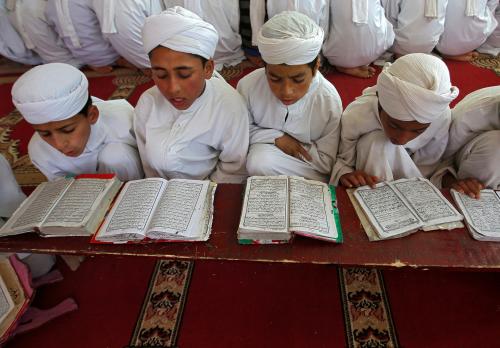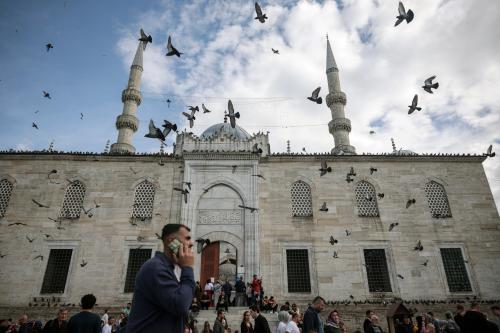This post is part of a series of analyses on the geopolitics of religious soft power.
In 2017, Mehran Kamrava published “The Great Game in West Asia,” a volume about Iranian and Turkish influence in the South Caucasus. Kamrava’s thesis is that Iran and Turkey have started a new geopolitical competition for influence in Armenia, Azerbaijan, and Georgia. However, the rivalry between Iran and Turkey is not new and the “power game” in the South Caucasus is not limited to these two middle powers. In fact, Iran and Turkey have been playing this game for years and the South Caucasus is still under strong influence from Russia. Nevertheless, Kamrava and the authors of the volume are right that the changing geopolitical situation has opened up new options for Iran and Turkey to influence this region.
How do these competing geopolitical influences work in the realm of religion? Iran’s and Turkey’s policies promote their respective official views of Shiism and Sunnism, and these religious components spill over into—and potentially become relevant for understanding—foreign policy. The target countries Azerbaijan and Georgia have inhabitants with the same religious affiliation as Iran and Turkey (Muslim majority and Muslim minority respectively), so it might make sense that these transnational religious affinities increase the chances for successful foreign policies. But do they? Does the religious factor make a growing Iranian or Turkish role attractive to target groups in the South Caucasus?
As Iran and Turkey do not by and large wield hard power in the South Caucasus, these policies fall largely under the category of “soft power”—although this concept originally was created in the context of liberal policies. Nevertheless, Iran’s and Turkey’s use of religion in the South Caucasus could be a reason for attractiveness depending on the country-specific geopolitical and historical situation. In what follows, I will argue that specific conditions such as the size of the target group are key to understand how religiously based soft power operates in the region.
In terms of geopolitics and international relations, the countries of the South Caucasus and their neighbors are highly interconnected, and this region has always been a sphere of influence for neighboring great powers. The two axes of alliances (Russia-Armenia-Iran and Turkey-Georgia-Azerbaijan) are related to the most relevant political and economic issues in the region: the disputed area of Nagorno Karabakh, the distribution of gas reserves in the Caspian Sea, gas pipelines to Europe, security politics, and trading agreements. Thus, neither the alliances nor the conflicts are directly related to religion. Predominantly Shiite Azerbaijan holds better relations with Georgia and Turkey whereas Shiite Iran cooperates best with Christian Armenia.
Iran for its part has supported Shiite groups in both Georgia and Azerbaijan. This support—with a peak in the late 1990s—has taken the form of financial help for religious communities, exchanges of clerics and students, stipends for studying in Iran, and funding for charity projects. In Azerbaijan—and particularly the south—Iran provided humanitarian aid during the height of the Nagorno Karabakh territorial dispute in the early 1990s and initiated Iranian broadcasting through the television channel Sahar TV. All these activities included religious components including, for example, the dissemination of religious literature.
Although the means Iran employed were largely the same in the two countries, the perception and results were completely different. In Georgia, the Shiite population is a minority mostly situated in the southeastern province of Kvemo Kartli. The Georgian government had initiated economic development programs in the region and worked to increase the numbers of students from Kvemo Kartli enrolled in Georgian universities. Thus, Iran’s approach became, in effect, an intervention in Georgia’s minority politics and the broader integration challenges of the Shiite community. Since Turkish universities also remained attractive for potential students, the two countries, in effect entered into competition over who could provide the more attractive educational and economic opportunities.
In contrast, Iranian support for Shiite groups in Azerbaijan operates according to a different logic. First, the target group is much larger, as Shiites are the majority in Azerbaijan. Since Azerbaijani Shiites were not well educated religiously, Iranian preachers attracted attention among young Shiites through an intellectually well-grounded style of religiosity. Although these preachers gained some popularity in a growing group of adherents, most researchers found that Iran only succeeded in influencing small portions of the population. Yet fears over the Iranian preachers’ potential reach alarmed secular political elites, who in turn created the influential narrative about dangerous “Iranian influence” that served to legitimize police action against certain Shiite groups and legal means against foreign religious preachers.
The Georgian government, observing the renewed emphasis on religion in the region, tried to counterbalance it with economic support programs. The Iranian activities in Georgia did not damage the bilateral relations whereas Azerbaijan’s bilateral relations with Iran remained precarious. Symbolic pan-Shiite solidarity between the countries’ leaders that masked significant tensions on the ground with respect to some Azerbaijani Shiite communities.
Interestingly, Iranian foreign policy uses religious promotion in other ways—primarily cultural policy—that go beyond the direct support of religious groups. This applies to bilateral relations between Iran and Armenia, where there are few Shiites. Nevertheless, Iran packages its religious outreach as a curious but benign form of cultural capital. Exhibitions, language courses, and other cultural activities have buttressed the political relationship for years.
Turkey’s inclusion of religion in foreign policy is different. In the 2000s, it benefited from the formal separation between the movement of Fethullah Gülen and the Turkish state’s directorate of religious affairs, or Diyanet. During this period, Turkish religious soft power in the Caucasus region was almost uniquely associated with the Gülen movement. Although the Diyanet supported the Sunni minority in Georgia’s Adjara region as well as some mosques and the Department of Religion at Baku State University in Azerbaijan, the Gülen movement was much more present and integrated throughout society as a modest form of pan-Turkism. Gülenist representatives in the region understood quite well how to emphasize their Turkish roots within other national contexts. Their schools attracted the children of both Georgians and Turkish diplomats or businesspersons. As the Gülen movement and the Turkish government were two separate institutions, Turkish policy was always able to balance religious soft power with its political interests in the two countries, allowing them to proceed in parallel.
The situation has changed dramatically since the rupture between Gülen and Erdoğan in 2013. Gülenist institutions in Azerbaijan have been closed down due to Turkish government pressure. Accordingly, Ankara will have to find a new balance between religious and political influence. Most experts expect a reduction of Turkish soft power in the region, noting that the Diyanet’s influence will not be embraced at the popular level in the same way that Gülenists had been in the past.
The success or failure of religious outreach strategies is a function of specific historical contingencies in target countries.
In short, the relevance of religion to soft power projection remains ambivalent. Religion can play a significant role in international relations as the basis of activities targeting and sometimes successfully influencing parts of a given national population. However, Turkey’s and Iran’s religious exports in the South Caucasus remain limited. Religion is certainly not the key to understanding the influence of these two powers in the South Caucasus. None of the bilateral relations concerned are fundamentally premised on religious grounds.
The analysis of religious soft power in these contexts gains most from looking at specific historical and geopolitical circumstances rather than by searching for universal patterns governing religion’s role in foreign policy. While Turkey’s or Iran’s religious policy might at some level be informed by diverging ideological and theological starting points, the success or failure of religious outreach strategies is a function of specific historical contingencies in target countries. Depending on the size of the targeted group, as we have seen above, the projection of religious soft power can become a significant factor in national security debates in one context while remaining a minor, even tangential aspect of policy towards minorities in others.
The fact that religious soft power exists as a tool in the foreign policy repertoire of some states does not mean that religion is something outside the political world or a force that somehow transcends geopolitical realities. Rather, the use of religious soft power by some states reflects a recognition of religion as deeply embedded in society and available as a resource for mobilization in certain bilateral relationships.
The Brookings Institution is committed to quality, independence, and impact.
We are supported by a diverse array of funders. In line with our values and policies, each Brookings publication represents the sole views of its author(s).





Commentary
Religious soft power in the South Caucasus: The influence of Iran and Turkey
December 13, 2018